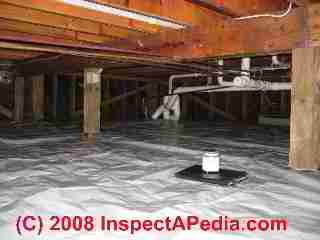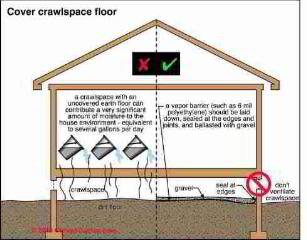 Inspect, Diagnose, & Repair Problems in Building Crawl Spaces
Inspect, Diagnose, & Repair Problems in Building Crawl Spaces
- POST a QUESTION or COMMENT about diagnosing and fixing problems in building crawl spaces
Building crawlspace inspection procedures, problem diagnosis, repair procedures.
This building crawl space article series explains how to inspect, diagnose problems in, and repair building crawl spaces, including crawl space insulation & leaks or moisture control.
Information is provided about visual clues of crawl space problems, such as evidence of a history of leaks, mold contamination, insect damage, structural damage, flooding, as well as evidence of hazardous materials and conditions such as the probable presence of animal allergens, asbestos, or mold.
InspectAPedia tolerates no conflicts of interest. We have no relationship with advertisers, products, or services discussed at this website.
- Daniel Friedman, Publisher/Editor/Author - See WHO ARE WE?
Crawl Areas Under Buildings
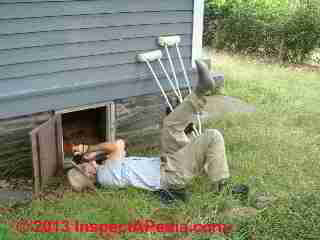 Defect Recognition, Repair, Prevention for Building Crawl Space Leaks, Mold, Insulation & Ventilation
Defect Recognition, Repair, Prevention for Building Crawl Space Leaks, Mold, Insulation & Ventilation
The page top sketch of the role of a dirt floor crawl space in building moisture and mold problems (above) is courtesy of Carson Dunlop Associates, a Toronto home inspection, education & report writing tool company [ carsondunlop.com ].
Photo just abovce is of the author, Daniel Friedman, peering into an inaccessible crawl space while suffering from a broken leg. Photo courtesy of Arlene Puentes. Friedman's experience includes residential & light commercial construction, inspection, troubleshooting & repair since the 1970s.
[Click to enlarge any image]
The list of concerns or problems in or due to building crawl spaces is long as would be a list of opinions about what to do with crawl spaces, wet crawl spaces, moldy crawl spaces, or crawl space insulation and ventilation.
Good building science combined with a lot of experience has led to some good information on how to correct crawl space problems. Here we list crawl space problem inspection, diagnosis, and cure. Here are some things to watch out for in a building crawl space:
- Crawl spaces may be unsafe to enter due to risk of asbestos, chemicals, collapse, hantavirus, mold, rodents, sewage, snakes or even electrical shock hazards.
See CRAWL SPACE SAFETY ADVICE where we explain when you should not even enter a crawl space. - Crawl spaces may be a source of building water, moisture, leaks, mold -
see CRAWL SPACE DRYOUT - home - this is the key article on dealing with wet or damp crawl spaces and related problems in buildings.
Also see CRAWL SPACE GROUND COVERS.
For a crawl space contaminated by burst drain piping or sewage backups or spills
see CRAWL SPACE SEWAGE CLEANUP
For avoiding foundation collapse in areas prone to flooding, also
see FLOOD VENTS & FLOOD PORTS. WATER ENTRY in BUILDINGS is the home page for our series of articles on the causes and cures of high indoor moisture, wet basements, wet crawl spaces, and moisture related problems like attic condensation and mold.
Also see MOLD in FIBERGLASS INSULATION - Crawl spaces may be a cause of building energy loss or increased heating bills, especially if the crawl space is improperly insulated and/or vented.
See CRAWL SPACE DRYOUT - home where we also discuss the change in thinking between the old-school idea of venting crawl spaces to the current best practice of converting crawl areas to a conditioned space, explained further
at CRAWL SPACE GROUND COVERS. - Crawl spaces are often a reservoir of hidden structural, rot, insect, mold, water, contaminant, or other problems, largely because most crawl areas are difficult to enter and are rarely inspected.
WOOD DESTROYING INSECTS carpenter ants, powder post beetles, & other wood destroying organisms are a special risk in crawl areas, especially if fiberglass insulation was run from crawl space floor right up the wall and onto building framing or flooring. - Crawl spaces may be cluttered with debris impeding inspection and inviting pests or rodents. Crawl spaces are required to be kept clear of debris; some such as wood scraps increase the risk of termite risk. For example from the 2012 IRC:
The under-floor grade shall be cleaned of all vegetation and organic material. All wood forms used for placing concrete shall be removed before a building is occupied or used for any purpose. All construction materials shall be removed before a building is occupied or used for any purpose. [1]
Key Crawl Space Inspection, Diagnosis, Repair articles
- AIR BYPASS LEAKS - stains on insulation may help spot air leaks from a crawl area into the occupied space
- BASEMENT LEAKS, INSPECT FOR - these water and leak control articles also apply to crawl spaces
- BASEMENT WATERPROOFING - these water and leak control articles also apply to crawl spaces
- BUCKLED FOUNDATIONS due to INSULATION? - does foundation insulation cause cracking visible in a basement or crawl space?
- COMBUSTION AIR for TIGHT BUILDINGS - if you have heating equipment in a crawl space be sure there is adequate combustion air in and venting of exhaust gases out
- CRAWL SPACES - home page for building crawl area topics
- CRAWL SPACE DRYOUT - home - this is the key article on dealing with wet or damp crawl spaces and related problems in buildings
- CRAWL SPACE VENTILATION CODES - should you ventilate the crawl area? Current best practices say no: dry, seal & condition the space
- DEW POINT CALCULATION for WALLS - why does condensation appear on a crawl space wall or on the ceiling above it ?
- DEW POINT TABLE - CONDENSATION POINT GUIDE
- EFFLORESCENCE SALTS & WHITE DEPOSITS - don't waste money testing white goop for crawl space mold if it is efflorescence, but efflorescence does indicate a source of crawl space moisture that needs attention
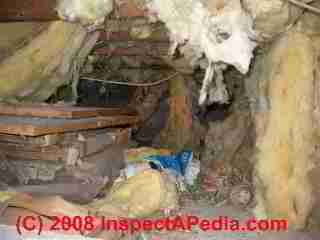
- FIBERGLASS INSULATION - can become mold contaminated in a crawl area, leading to mold contamination in the occupied space above
- FLOOD DAMAGE ASSESSMENT, SAFETY & CLEANUP - careful inspection of the crawl area is important
- FOUNDATION WATERPROOFING - for crawl areas
- INSULATION LOCATION for BASEMENTS & CRAWLSPACES - what insulation works best in crawl spaces? where should crawl space insulation be placed?
- MOISTURE CONTROL in BUILDINGS - key advice for drying out a wet crawl area
Key Crawl Space Water Entry Diagnosis and Cure Articles
- BASEMENT WATERPROOFING - use of sealers to help keep basements and crawlspaces dry
- BASEMENT LEAKS, INSPECT FOR - where and how water gets into basements and crawl spaces
- CRAWL SPACE DRYOUT - home - details about curing wet or damp crawl spaces.
- CRAWL SPACE GROUND COVERS - how to choose and place a ground cover for dirt floor crawl spaces, add heat, keep the crawl area dry
- CRAWL SPACE SEWAGE CLEANUP - how to clean up sewage contamination in a building crawl area
- EFFLORESCENCE SALTS & WHITE DEPOSITS - these white deposits are a great indicator of where moisture is penetrating a foundation
- HUMIDITY CONTROL & TARGETS INDOORS - so how dry should a building be for comfort and mold prevention?
- MOISTURE CONTROL in BUILDINGS - master list of detecting and controlling building moisture levels
- MOISTURE PROBLEMS: CAUSE & CURE - moisture and building energy loss
- SUMP PUMPS GUIDE - how and where to install a sump pump as an emergency backup against basement or crawl space flooding
- WATER ENTRY in BUILDINGS - causes and cures of un-wanted building leaks in all areas
- WET BASEMENT PREVENTION - how to stop basement flooding
List of additional building crawl space inspection and defect articles
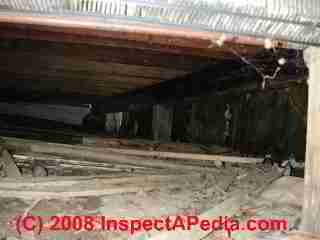
- ANIMAL or URINE ODOR SOURCE DETECTION - how to find and remove animal odors, pet urine odors, etc. - Is there a dead skunk in the crawl space below your home?
- ASBESTOS IDENTIFICATION IN BUILDINGS - are there asbestos hazards in the crawl space?
- BASEMENT WATERPROOFING and FOUNDATION WATERPROOFING collect articles on keeping water and moisture out of buildings
- Fiberglass Building insulation: are fiberglass particles a problem in the crawl space? Has the crawl space insulation become a mold reservoir?
- FLOOD DAMAGE ASSESSMENT, SAFETY & CLEANUP A Guide to Mold Cleanup Procedures
- HEAT LOSS in BUILDINGS, how to determine and calculate heat loss from a building crawl space (or heat gain in a cooling climate), how to evaluate building insulation, & how to insulate buildings
- HUMIDITY CONTROL & TARGETS INDOORS How Low Should You Keep the crawl space humidity to avoid a mold problem
- INSULATION INSPECTION & IMPROVEMENT: Insulation in crawl spaces: Identification, R-values, Heat loss, Insulation Types, Insulation Characteristics
- Mold Cleanup, How to clean or remove mold in crawl spaces
- Mold Prevention: Avoiding Mold Problems in crawl spaces by Using Mold-resistant Construction Products & Practices
- Mold Information Center: What to do about crawlspace mold, mold action plan, valid and invalid test methods, mold remediation
- ODORS GASES SMELLS, DIAGNOSIS & CURE - how to identify and remove all kinds of odors in crawl spaces
- WOOD DESTROYING INSECTS carpenter ants, powder post beetles, & other wood destroying organisms are a special risk in crawl areas
- Thermal Tracking & Stains how to recognize thermal tracking or thermal bridging & how to diagnose Stains on Ceilings & Walls, Building Air Leaks & Insulation Defects, as well as other indoor air quality or building concerns
- SUMP PUMPS GUIDE - does your crawl space need a sump pump?
- WATER ENTRY in BUILDINGS series of articles on the causes and cures of high indoor moisture, wet basements, wet crawl spaces, and moisture related problems like attic condensation and mold.
- WINTERIZE A BUILDING - how to protect a building and its plumbing and mechanical systems from freeze damage, how to shut down a building to minimize damage; how to de-winterize a building.
...
Reader Comments, Questions & Answers About The Article Above
Below you will find questions and answers previously posted on this page at its page bottom reader comment box.
Reader Q&A - also see RECOMMENDED ARTICLES & FAQs
Question: What is the Best Approach to Drying out a Flooding Crawl Space?
I have been battling crawl-space moisture and ponding water problems for about 2 years now and am desperately requesting your pro-bono assistance and consultations. I am living in a senior citizen retirement house that I inherited from my deceased parents.
I am on total permanent Social Security Disability for almost 10 years now. This is my only income which is $1300 per month. After many many hours, weeks, and months of calling people, searching the internet etc., I came across your excellent article and web-site.
I knew from reading your material that you are the people I need to help me navigate properly through all the people and companies I have been in contact with. I didn't, (and still don't) know where to start first.
This house was built in a senior citizen community where the water-table is high and the ground gets soaked around the perimeter of the foundation and other areas of the property during heavy and even not-so-heavy rains. I have a dirt crawl-space that gets puddles in it and had a termite inspector put a not-so-good sump pump in it that the water never reaches.
Then another person told me I had mold in there and several other people told me I didn't. Had an excavator look and he told me the dirt needed to be pitched and leveled but he's never done that in a crawl space before. Even when the termite guy dug some trenches, the water just sat in the trenches.
I had water-proofing companies come and tell me differing things, all wanting thousands of dollars and none guaranteeing anything. Some say encapsulation and inside french drains, some say that's not good and outside french drains, some say putting more wall wells and vents in or digging the dirt out more so that water won't come in the vents. I consulted with a hydro science company that also said to just clean the gutters (which I already had done and they have that netting over them so they weren't too bad) and clean or get new downspouts. And it goes on and on and on.
I want to get the right people to start at the right place but am thoroughly confused now. I got free weatherization from the state because I am on limited income and on medicare, paad, and food stamps. They wrapped the pipes down there and put in a cheap black moisture barrier and fiberglass insulation on top.
I have heard and read that may make the moisture and mold problems worse. Recently I have noticed a mildew-like moldy smell coming from my forced-air gas baseboard registers and read when I put the heat on it will spread and contaminate the house even more with mold spores.
I know my carpeting needs to be removed and house painted but have been putting if off because I realize I need to get the water/moisture issues identified first as well as the mold problems corrected. I had the bathroom painted in April and shortly after I noticed the paint cracked on the ceiling which is near the attic where I suspect there may be water/mold damage.
This, I think is probably from a couple of years ago when my central air was dripping and we had a new a/c put in. So I am asking you for your help in testing for molds and dust particle analysis as well as directing me to the correct professionals in the proper order to resolve all these issues. Thank you very much for your kind consideration and assistance in advance, - B.B., Toms River NJ
Reply: Here is a Step by Step Approach to Wet Crawl Spaces
Thank you for the interesting or I should say challenging water entry question - it helps us realize where we need to work on making our text more clear or more complete. A competent onsite inspection by an expert usually finds additional clues that help accurately diagnose a problem.
That said, here are some things to consider,interspersed with your remarks from your own note:
I have a dirt crawl-space that gets puddles in it and had a termite inspector put a not-so-good sump pump in it that the water never reaches.
Puddles in a dirt crawl space below a home, even just wet soils, invite problems with building mold contamination and wood destroying insects such as termites and carpenter ants. It's certainly a problem that needs correction. Divide your wet crawl space solution thinking into these three main topics:
- how to stop water from entering the crawl area
- how to get rid of water and moisture therein
- how to evaluate the building for related damage (mold, termites) that may need attention
Then another person told me I had mold in there and several other people told me I didn't.
If mold is not visible and there are no health complaints there might not be a big mold problem, or there may be one but as mold does not affect everyone to the same degree, you may not have noticed it.
See our article on MOLD / ENVIRONMENTAL EXPERT, HIRE ?, for help in deciding if it is cost justified or otherwise appropriate to perform some expert inspecting and testing for mold. Don't rely on mold tests without an inspection by an expert.
If your expert finds that there is a significant mold problem originating in the crawl area, also see CRAWLSPACE MOLD ADVICE.
Had an excavator look and he told me the dirt needed to be pitched and leveled but he's never done that in a crawl space before.
I agree with your excavator - if the crawl space is not sloped to a common drain point you cannot easily remove water therein. It's best not to have water enter the crawl in the first place since if we let water enter but then pump it out, we are still facing mold and insect troubles stemming from high moisture in the area.
Even when the termite guy dug some trenches, the water just sat in the trenches.
This means that the soil has a slow percolation rate. Trenches need to be pitched to a common drain point where a sump pump removes water.
I had water-proofing companies come and tell me differing things, all wanting thousands of dollars and none guaranteeing anything.
Beginning with our article titled CRAWL SPACES and also CRAWL SPACE DRYOUT - home you will see an organized approach to curing a wet crawl space.
The number one water entry step is gutter and leader maintenance.
You think your gutters are "clean" but a mere handful of leaves can clog a downspout and lead to gutter overflow and spillage around the building so you will want to inspect the gutter and downspout system during a heavy rainfall. Make sure downspouts drain far enough from the building that water does not enter at those locations.
Some say encapsulation and inside french drains, some say that's not good and outside french drains, some say putting more wall wells and vents in or digging the dirt out more so that water won't come in the vents.
Simpler and less expensive are steps to stop water entry from outside, combined with a sloped crawl surface to a common sump pit (see SUMP PUMPS), combined with 6 mil poly over the dirt to stop pumping soil moisture into the area (see CRAWL SPACE VAPOR BARRIER LOCATION).
I consulted with a hydro science company that also said to just clean the gutters (which I already had done and they have that netting over them so they weren't too bad) and clean or get new downspouts.
Your hydro science company was pointing to the number one cause of wet crawl spaces
Question: Problems with odors from poly vapor barriers on crawl space floors
I have a dirt crawl space under my bedroom floor which is causing me some health problems. I am extremely allergic to mold and my husband put 6 ply visqueen on dirt floor & 2 vents in block. I became extremely sick from visqueen order and I removed it, still feeling sick but not as bad. I am closing off the 2 vents to avoid anymore air flow in crawl space.
However, I want to put something down overtop the dirt floor and adhere it to the concrete walls to avoid any further allergy problems plus have cleaner air flow in our bedroom....but the plastic's are mostly made of polyurethane which might be sensitive too also or with the combinations and exposure to the dirt floor caused more airborne mold spores & allergies.
Even in the middle of the night I feel like something is crawling & biting me....and my husband is coughing something awful and we both have headaches & sinus, breathing problems too, nausea, disoriented and confusion. I am very worried about this and want it repaired ASAP before its too late.
I am looking for something to cover & seal the dirt flooring but want something that is chemical free. I would also like to know if it would be wise to put insulation up underneath the bedroom floor to help prevent from coming up thru the floor into the bedroom?
Any information, suggestions, ideas would be greatly appreciated. thank you! - Suzanne
Reply:
Suzanne, When choosing a poly vapor barrier for a crawl space beneath your home, indeed it makes sense to do a sniff test - some of the white 6-mil plastic vapor barriers I've seen used by building remediators were virtually odorless;
In other cases we placed the poly outdoors in the sun for a few days to help it complete its outgassing before putting it down in a crawl area. Indeed I've been bothered by horrible odor outgassing from some poly ground covers too.
You could also pour a concrete floor in the crawl area - a more costly solution that has its own concerns with temporary high moisture levels. More suggestions are
at CRAWL SPACE GROUND COVERS where we describe ways to cover up dirt and stop moisture movement into the structure from the crawl space floor. Also
see VAPOR BARRIERS & CONDENSATION in BUILDINGS.
But I wouldn't be too hasty to assume that plastic odors are the only concern, perhaps not even the main one, in your home. A damp dirt floor crawl space could have led to a mold problem or there could be other health and IAQ issues coming from that location or even elsewhere in the building. For example there could be hard-to-see mold contamination on wood surfaces or in fiberglass insulation if it has been exposed to wet or dampness.
(See INSULATION MOLD CONTAMINATION TEST).
At MOLD INFORMATION CENTER (article link at the ARTICLE INDEX the bottom of this article ) you can
find MOLD / ENVIRONMENTAL EXPERT, HIRE ? - that might help you decide if it's appropriate to bring in an expert for a more thorough building inspection and perhaps some tests. I'd be reluctant to ONLY blame the plastic odors (though those have bothered me too at times).
Question: What should be inspected in building crawl areas?
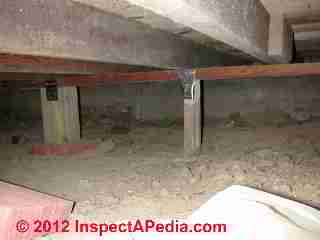 I am the VP for a condo association. The units are approximately 35 years old and when the last couple of unit have sold, the home inspector found a number of issues within the crawl spaces.
I am the VP for a condo association. The units are approximately 35 years old and when the last couple of unit have sold, the home inspector found a number of issues within the crawl spaces.
The units (42) are individual town home type with individual unit crawl spaces.
Some are physically divided by foundation, and some are divided by fire rated dry wall. We would like to know if you have any examples of what we should expect from an inspection of the crawl spaces as we are going to engage a firm to do the inspection for the association. - Anon. 1/2/2014
Reply:
Perhaps because the range of components and building systems that may or may not be present in a crawlspace is so great, no crawlspace-specific inspection list is likely to be exhaustive or complete. Indeed inspectors have strong opinions about the inspection of that area of any building.
I'll make some general suggestions below. If you want to send me examples of what reports & photographs have already been provided for your buildings I can then form a better view of the nature of the construction of the townhomes and thus would have a more specific opinion.
I agree that crawlspace inspection is important: problems tend to develop further and to a more severe extent precisely in building areas that are difficult to access.
First: the inspection report must indicate whether or not a crawlspace exists at the building; presuming that one is present beneath each of the 42 units in your case, the report must indicate whether or not the crawlspace was entered and inspected or not.
Some conditions such as flooding, unsafe wiring, contamination, or limited safe access space can either limit or even preclude actual entry of a crawl space.
Ultimately the decision to enter or not enter a crawl area must be up to the inspector in the field, as s/he may observe specific safety concerns that would lead the inspector to decline to enter the space. In that case the report must indicate the inspection limitations and if the space was not entered, the report needs to explain why.
If I were writing such a report, based on what I could determine about the building and its risk points, I'd have additional recommendations for inaccessible areas. For example where a crawl area is completely inaccessible one needs to decide based on other site and building observations whether or not there are clues suggesting either damage or risk of conditions serious enough to justify destructive or invasive measures to gain view or access to the area. .
Second: for entered crawl spaces surely the scope of inspection will cover all structural and mechanical systems and components that are present therein. For example (this cannot be a complete list as I know nothing of building specifics) the inspector would report
- Watch out: start with Safety concerns, particularly immediate safety & health concerns for building occupants such as risk of structural collapse, fire, electrical hazards, unsafe heating equipment, sewage spills, rodent infestation, significant mold contamination
- Nature of & condition of construction: visible materials of the foundation, piers, footings (if present/visible), framing, insulation, presence of mechanical components, wiring, etc.
- Fire barriers: where the building is a multiple occupancy/multiple living unit, the presence & condition of fire barriers between crawl spaces as required by local building codes should be reported
- Evidence of water entry, flooding, drainage problems. At InspectApedia you'll find that many of our articles address water and moisture related problems in crawl spaces.
- Evidence of visible damage to the foundation walls
- Evidence of rot or wood destroying insect damage to the building and depending on qualifications and contract, evidence of activity of wood destroying insects
- Visual evidence of mold contamination or other obvious hazards (burst sewage pipes, damaged or improper wiring)
- If insulation is present, and if so, installation or condition defects; If no insultion is present, is it needed? Is there evidence of frost damage?
- If mechanical components are present, such as under-floor heaters, water tanks, or other equipment are located in a crawl space their condition should be inspected and reported just as for other building mechanical systems, with the added notation that limited access can often interfere with proper inspection and maintenance of mechanicals
While many inspectors stop the scope of their service at the level of reporting their direct observations (materials, conditions, defects) in my OPINION a true professional will also be sure that you, the client, are given to understand the significance of these findings and are told clearly where there is evidence of unsafe conditions or the need for repairs.
For example, water entry in a crawl space can affect the entire building, inviting insect damage, rot, mold contamination, wiring damage, damage to mechanical components, and even moisture problems in other building areas, even in the building's attic.
Watch out: in my OPINION what would not be helpful or particularly useful would be an "inventory checklist" type of inspection report that simply indicates the type of construction and materials. And a limited report that lists observations but gives you no idea of their relative import nor of the need for repairs nor of safety hazards is also of limited value.
...
Continue reading at CRAWL SPACE ACCESS or select a topic from the closely-related articles below, or see the complete ARTICLE INDEX.
Or see these
Recommended Articles
- CRAWL SPACES - topic home
- CRAWL SPACE ACCESS
- CRAWL SPACE CLEAN UP
- CRAWL SPACE DEBRIS
- CRAWL SPACE DEHUMIDIFICATION
- CRAWL SPACE DRYOUT - home
- CRAWL SPACE DEHUMIDIFICATION
- CRAWL SPACE DRY-OUT PROCEDURE
- CRAWL SPACE GROUND COVERS
- CRAWL SPACE INSULATION RETROFIT
- CRAWL SPACE MOISTURE BARRIERS
- CRAWLSPACE MOLD ADVICE
- CRAWL SPACE SAFETY ADVICE
- CRAWL SPACE SEAL & SANITIZE
- CRAWL SPACE SEWAGE CLEANUP
- CRAWL SPACE VAPOR BARRIER LOCATION
- CRAWL SPACE VENTILATION CODES
- CRAWL SPACE WATER ENTRY STOP
- CRAWL SPACE WATERPROOFING
- CRAWL SPACE INSPECTION
- CRAWL SPACE SAFETY ADVICE
Suggested citation for this web page
CRAWL SPACES at InspectApedia.com - online encyclopedia of building & environmental inspection, testing, diagnosis, repair, & problem prevention advice.
Or see this
INDEX to RELATED ARTICLES: ARTICLE INDEX to CRAWL SPACES
Or use the SEARCH BOX found below to Ask a Question or Search InspectApedia
Ask a Question or Search InspectApedia
Try the search box just below, or if you prefer, post a question or comment in the Comments box below and we will respond promptly.
Search the InspectApedia website
Note: appearance of your Comment below may be delayed: if your comment contains an image, photograph, web link, or text that looks to the software as if it might be a web link, your posting will appear after it has been approved by a moderator. Apologies for the delay.
Only one image can be added per comment but you can post as many comments, and therefore images, as you like.
You will not receive a notification when a response to your question has been posted.
Please bookmark this page to make it easy for you to check back for our response.
IF above you see "Comment Form is loading comments..." then COMMENT BOX - countable.ca / bawkbox.com IS NOT WORKING.
In any case you are welcome to send an email directly to us at InspectApedia.com at editor@inspectApedia.com
We'll reply to you directly. Please help us help you by noting, in your email, the URL of the InspectApedia page where you wanted to comment.
Citations & References
In addition to any citations in the article above, a full list is available on request.
- Dickson, Bruce. Guide to Closing and Conditioning Ventilated Crawlspaces. US Department of Energy, Energy Efficiency & Renewable Energy, 2013.
- De Haven, E. S. "Approximate hazard ratings and venting requirements from CSI‐ARC data. An up‐to‐date review of methods for analyzing single‐and multiple‐reaction data from adiabatic‐reaction calorimeters." Plant/Operations Progress 2, no. 1 (1983): 21-26.
- [1] International Residential Code, IRC Section R408, Under Floor Space, http://publicecodes.cyberregs.com/icod/irc/2012/icod_irc_2012_4_sec008.htm, retrieved 3/2/2013
- [3] Arlene Puentes [Website: www.octoberhome.com ] , an ASHI member and a licensed home inspector in Kingston, NY, and has served on ASHI national committees (Bylaws, Standards), as well as HVASHI Chapter President. Ms. Puentes can be contacted at ap@octoberhome.com
- Mark Cramer Inspection Services Mark Cramer, Tampa Florida, Mr. Cramer is a past president of ASHI, the American Society of Home Inspectors and is a Florida home inspector and home inspection educator. Mr. Cramer serves on the ASHI Home Inspection Standards. Contact Mark Cramer at: 727-595-4211 mark@BestTampaInspector.com
- John Cranor [Website: /www.house-whisperer.com ] is an ASHI member and a home inspector (The House Whisperer) is located in Glen Allen, VA 23060. He is also a contributor to InspectApedia.com in several technical areas such as plumbing and appliances (dryer vents). Contact Mr. Cranor at 804-873-8534 or by Email: johncranor@verizon.net
- In addition to citations & references found in this article, see the research citations given at the end of the related articles found at our suggested
CONTINUE READING or RECOMMENDED ARTICLES.
- Carson, Dunlop & Associates Ltd., 120 Carlton Street Suite 407, Toronto ON M5A 4K2. Tel: (416) 964-9415 1-800-268-7070 Email: info@carsondunlop.com. Alan Carson is a past president of ASHI, the American Society of Home Inspectors.
Thanks to Alan Carson and Bob Dunlop, for permission for InspectAPedia to use text excerpts from The HOME REFERENCE BOOK - the Encyclopedia of Homes and to use illustrations from The ILLUSTRATED HOME .
Carson Dunlop Associates provides extensive home inspection education and report writing material. In gratitude we provide links to tsome Carson Dunlop Associates products and services.


